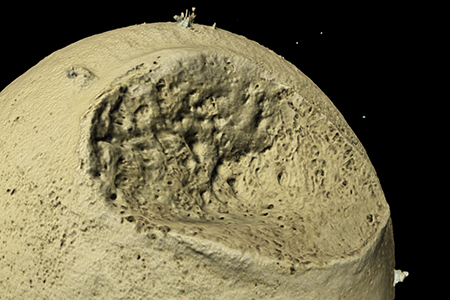New cause of osteoarthritis identified
Published on
 Micro CT scan of the head of a femur (thigh bone) showing the presence of sharp HDMPs on the surface of the bone
Micro CT scan of the head of a femur (thigh bone) showing the presence of sharp HDMPs on the surface of the bone
A new mechanism of joint destruction caused by a natural material that grinds away healthy cartilage and worsens osteoarthritis has been identified in human hip joints for the first time by University of Liverpool scientists.
The scientists, with Professor Alan Boyde and colleagues from Queen Mary University of London, were studying the hip of a man with the genetic condition, alkaptonuria (AKU), This is a metabolic disease in which a substance called homogentisic acid accumulates in joint cartilage, causing changes to its physical properties.
High density mineralised protrusions
The study revealed the presence of high density mineralised protrusions (HDMP), which have only been seen before in horses. These protrusions are caused as the body acts to fill in cracks in joint cartilage and can snap off, leading to sharp, dense particles in the joint which grind against healthy tissue.
To confirm the findings, the team studied eight hips donated for research by people with osteoarthritis and found the same results as in the alkaptonuria patient. [callout title= ]“The discovery of HDMP in humans means that for the first time we are seeing an important mechanism in the process which causes the disease"[/callout]
Professor Jim Gallagher led the study in Liverpool. He said: “There is no cure for osteoarthritis, but it is one of the leading causes of disability, causing immense pain and difficulty of movement to sufferers.
“The discovery of HDMP in humans means that for the first time we are seeing an important mechanism in the process which causes the disease. In effect these small, sharp particles could act like an abrasive powder scouring the surfaces of the joint.”
The researchers studied the joint without taking out the calcium - a method which is typically used to make bones softer and easier to examine. This process, which involves using acid, would normally have the effect of destroying the HDMPs thus explaining why they have not been recognised before in humans.
New piece to the puzzle
Professor Gallagher, from the University’s Institute of Ageing and Chronic Disease concluded: “Studying a rare illness like alkaptonuria is a worthwhile project in itself, but it can also help with new insights into much more common diseases.
“This is a case in point, and because of our work on alkaptonuria, we are now able to add a new piece to the puzzle of an illness that affects millions.”
The study, published in the Journal of Anatomy, recommends that searching for these HDMPs should now be included in the study of patients with osteoarthritis.
The study was supported by the AKU Society and the Rosetrees Trust. Read the full paper here.
Find out more about studying at Liverpool on the University’s study pages or follow the Institute on Twitter.
[callout title=More]New method increases targeted bone volume by 30 percent[/callout]